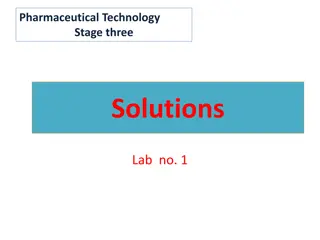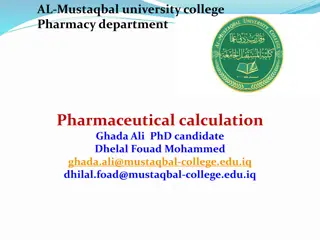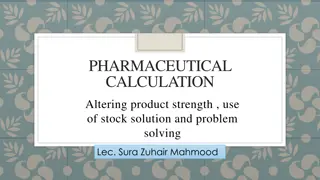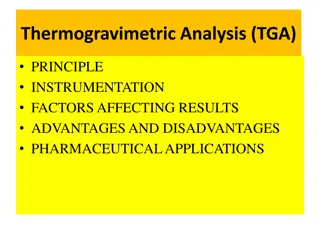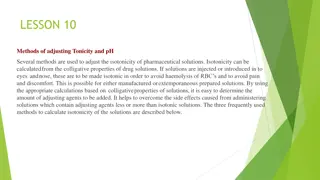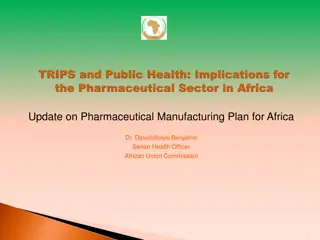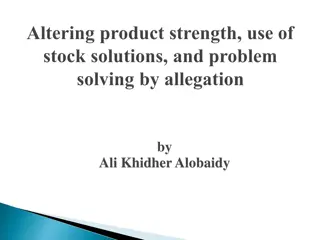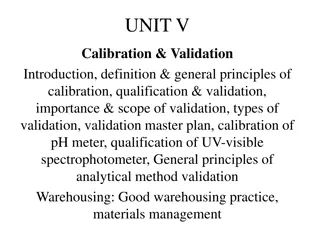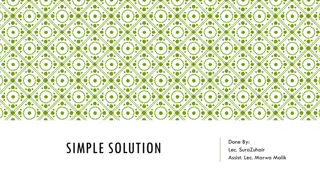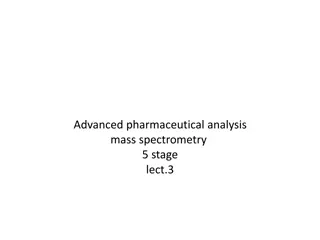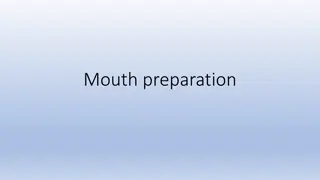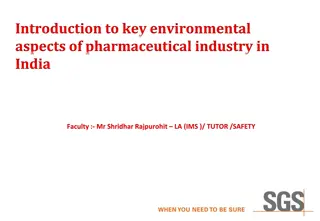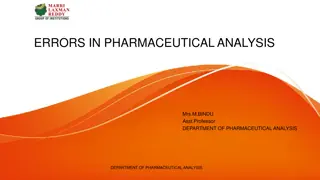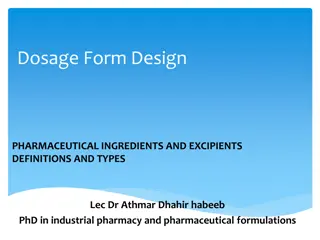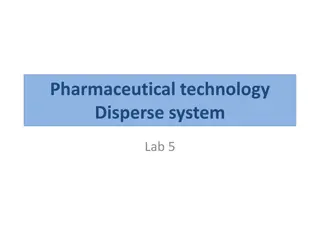Understanding Pharmaceutical Solutions and Their Preparation Processes
Pharmaceutical solutions are liquid preparations containing chemical substances dissolved in suitable solvents to form a single-phase system. This article delves into different types and classifications of solutions, including standard solutions and those prepared through various methods. It also provides insights into overcoming challenges in solution preparation, such as enhancing solubility and managing gas liberation. The general procedure for preparing simple solutions is outlined, emphasizing proper measurement and labeling techniques.
- Pharmaceutical Solutions
- Solution Preparation
- Standard Solutions
- Types of Solutions
- Overcoming Challenges
Download Presentation

Please find below an Image/Link to download the presentation.
The content on the website is provided AS IS for your information and personal use only. It may not be sold, licensed, or shared on other websites without obtaining consent from the author. Download presentation by click this link. If you encounter any issues during the download, it is possible that the publisher has removed the file from their server.
E N D
Presentation Transcript
Pharmaceutical Technology Stage three Solutions Lab no. 1
Solutions are liquid pharmaceutical preparation contain one or more chemical substance dissolved in one or more suitable solvent to produce single phase system
Standard solution Standard or (stock solution):- are solutions concentrations are exactly measured ) these are strong solutions from which weaker solutions are present ). of known concentrations (i.e.
Classifications of solutions according to the procedure of preparation 1. Solutions prepared by simple solution method 2. Solution prepared by chemical reactions 3. Solution prepared by simple solution with sterilizations such as ophthalmic solution, anticoagulant ,irrigating solution , physiological solution 4. Solution prepared by extraction.
Notes :- We can overcome some problems that may occur during preparation of solutions by following: 1. To increase the solubility of substances ,we can reduce the particle size by using mortar and pestle (example crystal form ,large particles) 2. If we have two solvents in the same prescriptions , we dissolve the solid substance in the solvent that have more ability to dissolve it (alcohol, water). 3. If we have material that has very fine particle size we must not use stirrer in dissolving it because particles will adhere around stirrer, so we use circulating of the beaker instead of stirrer . 4. If there is liberation of any gas , the container must be opened , without using stopper , until liberation of gas . 5. Some times we need to increase the solubility by certain method ex. pH , complexation .
General procedure of preparation of simple solution 1-Weigh the solid ingredient and put it in beaker 2-Subtract the volume of liquid ingredients (if present from of the final volume of prescription. 3-dissolve the solid ingredients in the remaining amount of the vehicle 4-Add the liquid ingredient 5-Convert the content of the beaker into the measuring cylinder and complete the volume up to the required amount by addition of the vehicle 6-transfer the content of the measuring cylinder to a wide mouth bottle and put suitable label (label of external use is pink ,while label for internal use )
Carminative mixture for infants Rx Sodium bicarbonate 0.06 g Aromatic spirit of ammonia 0.06 ml Compound tincture of cardamom 0.12 ml Glycerin 0.3 ml Peppermint water Q.S 4 ml Ft. mist Mitt 40 ml Sig t.i.d pc Calculations Factor = 40/4= 10 Sod. bicar.= 0.06 x 10= 0.6 gm Ar.sp .of ammonia = 0.06 x 10= 0.6 ml Comp. tr. of cardamom = 0.12 x 10= 1.2 ml Glycerin = 0.3ml x 10= 3 ml Peppermint water = 4 x 10= 40 ml 40 x = 30 ml 30 ml (0.6+ 1.2+3ml) =25.2 ml
Procedure 1. Dissolve 0.6 g sod. bicarb in 25.2 ml of pepp. water in beaker. 2. Add 0.6 ml of Ar. spirit of ammonia ,1.2 ml of comp. tr. cardamom and 3 ml of glycerin to the content of the beaker . 3. Convert the content of the beaker into measuring cylinder and complete the volume up to 40 ml by addition of pepp. water . 4. Transfer the content of the measuring cylinder to a wide mouth bottle and put a suitable label. Note:- Glycerin act as soothing and sweetening agent .
Carminative mixture for adult (H.W) Rx Sodium bicarbonate gr vii Aromatic spirit of ammonia xv Compound tincture of cardamom x Strong tincture of ginger i Peppermint water Q.S f Fit.mist Mitt f iv Sig. f ss t.i.d p.c. Procedure as the procedure of mist carminative of infant
Notes Sodium bicarb .act as gastric antacid. Aromatic spirit act as carminative agent. Comp.tr. cardamom act as flavoring agent Tr.of ginger act as flavoring and antispasmodic agent. Pepp. water act as flavoring and carminative agent ,also it is diluting agent used as solvent. Strong tr. of ginger which is used in carminative mixture of adult must not added for infant because it is strong for use to infant.
Aqueous iodine solution (lugals sol) Rx Iodine 50 g Potassium iodide 100 g Purified water Q.S 1000 ml Sig 0.3 ml diluted with milk or water three times daily Procedure 1. Dissolve iodine in concentrated KI solution 2. Shake well until iodine dissolved 3. Complete the volume with purified water to 1000 ml Notes: Lugals sol. Used internally in treatment of thyrotoxicosis (preoperative treatment ) and in hypothyroidism We dissolve the iodine in KI instead of water because the iodine has more solubility in KI than in water.
Weak iodine solution (tr. Iodine) Rx Iodine 25 g K. Iodide 15 g Dis. Water 25 ml Alcohol 90% 1000ml Sig. bid used externally Procedure The same method as lugals sol. except completing the volume with alcohol 90% to 1000 ml Strong iodine solution Rx Iodine 100 g K. Iodide 60 g Dis. Water 100 ml Alcohol 90% 1000ml Note :- weak and strong iodine solution used as antiseptic
Mandles paint throat paint Rx KI 25 g Alcohol 90% 40 ml Water 25 ml Iodine 12.5 g Peppermint oil 4ml Glycerol Q.s 1000ml Note :- Throat paint used for tonsillitis and pharyngitis Procedure 1. Dissolve 25 g of KI in 25 ml of water 2. Dissolve 12.5 g of iodine in KI solution 3. Dissolve 4 ml of peppermint oil in 40 ml of 90% alcohol ,and transfer it to iodine sol. then mix 4. Complete the volume to 1000 ml by glycerin Note :- Iodine used as antiseptic Glycerol used as preservative Pepp.oil used as flavouring agent This paint dispensed in coloured bottles with stopper.
Sol. I and Sol. II Sol I sodium thiosulfate 15-20% Sol II tartaric acid 3-5% Sig. apply sol I then after two minutes apply sol II on the skin. Procedure By simple solution method Notes:- This prescription used as antifungal We can not mix sol I and sol II in the same bottle due to the chemical reaction between them which we use it to precipitate the sulphur in infected area of the skin as antifungal


